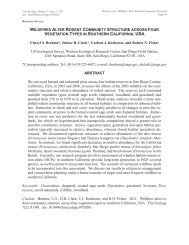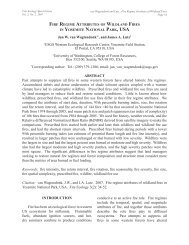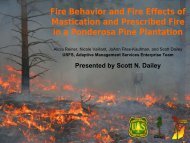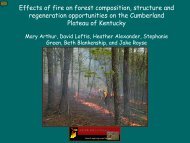Current Titles in Wildland Fire, May 2012 - Association for Fire Ecology
Current Titles in Wildland Fire, May 2012 - Association for Fire Ecology
Current Titles in Wildland Fire, May 2012 - Association for Fire Ecology
You also want an ePaper? Increase the reach of your titles
YUMPU automatically turns print PDFs into web optimized ePapers that Google loves.
<strong>Current</strong> <strong>Titles</strong> <strong>in</strong> <strong>Wildland</strong> <strong>Fire</strong>, <strong>May</strong> <strong>2012</strong><br />
Author(s): Fordham, D. A., Resit Akcakaya, H., Araujo, M. B., Elith, J., Keith, D. A., Pearson, R.,<br />
Auld, T. D., Mell<strong>in</strong>, C., Morgan, J. W., Regan, T. J., Tozer, M., Watts, M. J., White, M., W<strong>in</strong>tle, B.<br />
A., Yates, C. And Brook, B. W.<br />
Title: Plant Ext<strong>in</strong>ction Risk Under Climate Change: Are Forecast Range Shifts Alone A Good<br />
Indicator of Species Vulnerability to Global Warm<strong>in</strong>g<br />
Source: Global Change Biology 18: 1357-1371 Year: <strong>2012</strong> Keywords: Climate <strong>Ecology</strong><br />
Abstract: Models that Couple Habitat Suitability With Demographic Processes Offer A<br />
Potentially Improved Approach <strong>for</strong> Estimat<strong>in</strong>g Spatial Distributional Shifts and Ext<strong>in</strong>ction Risk<br />
Under Climate change. Apply<strong>in</strong>g Such An Approach to Five Species of Australian Plants With<br />
Contrast<strong>in</strong>g Demographic Traits, We Show That: (i) Predicted Climate-driven Changes <strong>in</strong> Range<br />
Area Are sensitive to the Underly<strong>in</strong>g Habitat Model, Regardless of Whether Demographic<br />
Traits and Their Interaction With Habitat Patch Configuration Are Modeled Explicitly; and (ii)<br />
Caution Should Be exercised When Us<strong>in</strong>g Predicted Changes <strong>in</strong> Total Habitat Suitability or<br />
Geographic Extent to Infer Ext<strong>in</strong>ction Risk, Because the Relationship Between These Metrics is<br />
Often Weak. Measures of ext<strong>in</strong>ction Risk, Which Quantify Threats to Population Persistence,<br />
Are Particularly Sensitive to Life-history Traits, Such as Recruitment Response to <strong>Fire</strong>, Which<br />
Expla<strong>in</strong>ed Approximately 60% of the Deviance <strong>in</strong> Expected M<strong>in</strong>imum Abundance. Dispersal<br />
Dynamics and Habitat Patch Structure Have the Strongest Influence on the Amount of<br />
Movement of the Trail<strong>in</strong>g and Lead<strong>in</strong>g Edge of the Range Marg<strong>in</strong>, Expla<strong>in</strong><strong>in</strong>g Roughly 40% of<br />
Modeled Structural Deviance. These Results Underscore the Need to Consider Direct<br />
Measures of Ext<strong>in</strong>ction Risk (population Decl<strong>in</strong>es and other Measures of Stochastic Viability),<br />
as Well as Measures of Change <strong>in</strong> Habitat Area, When Assess<strong>in</strong>g Climate Change Impacts on<br />
Biodiversity. Furthermore, Direct Estimation of Ext<strong>in</strong>ction risk Incorporates Important<br />
Demographic and Ecosystem Processes, Which Potentially Influence Species' Vulnerability to<br />
Ext<strong>in</strong>ction Due to Climate Change. How to Locate: Contact Damien.<strong>for</strong>dham@adelaide.edu.au<br />
Author(s): Fraver, S., Palik, B. J.<br />
Title: Stand and Cohort Structures of Old-growth P<strong>in</strong>us Res<strong>in</strong>osa-dom<strong>in</strong>ated Forests of<br />
Northern M<strong>in</strong>nesota, Usa<br />
Source: Journal of Vegetation Science 23: 249-259 Year: <strong>2012</strong> Keywords: <strong>Ecology</strong> Abstract:<br />
the Wide Range of Stand and Age-cohort Structures <strong>in</strong> These Old-growth P. Res<strong>in</strong>osa Stands<br />
Depicts Pre-settlement Forests More Complex Than Those of the S<strong>in</strong>gle-cohort, Post-standreplac<strong>in</strong>g-fire<br />
Model that Has Guided Regional Forest Management. With<strong>in</strong>-stand Patch<strong>in</strong>ess<br />
of Cohort Age Structures Implies Disturbances Operat<strong>in</strong>g at Scales Smaller Than Typically<br />
Associated with This Regional Forest Type. Presence of Non-p<strong>in</strong>e "<strong>in</strong>growth' on All Sites Might<br />
Suggest that P. Res<strong>in</strong>osa Stands Support<strong>in</strong>g These Species Lie With<strong>in</strong> the Natural Range of<br />
Variability <strong>for</strong> This community Type, Represent<strong>in</strong>g Situations <strong>in</strong> Which Surface <strong>Fire</strong>s Did Not<br />
Occur <strong>for</strong> Extended Periods or Were Spatially Patchy at the Stand Scale. The Diversity of<br />
Reference Conditions documented Here Suggests Targets that Might Guide Ecological<br />
Restoration Prescriptions <strong>for</strong> These Ecosystems, With the Goal of Re<strong>in</strong>troduc<strong>in</strong>g Structural and<br />
Compositional Complexity reflect<strong>in</strong>g Natural Disturbance and Stand Development. How to<br />
Locate: Contact Sfraver@fs.fed.us<br />
26








